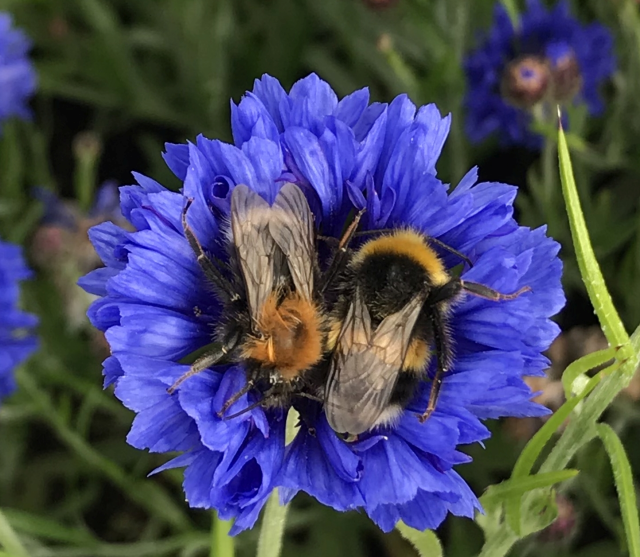
Icelandic bumble bees, seen on my 2018 trip to the ice island. Chilled by a cold rainy summer, they are just waking up as the clouds began to unveil the sun. (Photo: Jane Miksha)
In the past three or four years, I began to notice that honey bees aren’t the only bees in the world. What a surprise! There are over 20,000 other versions. Some as big as elephants, some as small as pin heads. Perhaps I exaggerate a little, but the range in shape, colour, and size of bees is impressive.
I’m still a western honey bee enthusiast, enamoured by their manners and their advance form of civilization. I still want to be buried in a beehive when I die. But I’ve been researching bee ecology at the University of Calgary and have become more and more fond of the other species. Pollinator Week, which begins today, June 17, reminds us all to notice the other pollinators – including some ants, butterflies, bats, birds, and several hundred other creatures.

The elephant shrew, practicing on sugar before moving on to nectar.
Among the more unusual/ignored pollinators are bats, toads, and mongooses (mongeese?). The BBC has a fun page that talks about mongoslings which transport pollen while snacking on nectar (to wash the taste of cobra from their mouths, I suppose). BBC also mentions the elephant shrew which uses its elephant nose to probe flowers for pollen and nectar, spreading goodies from blossom to blossom. (Incidentally, this mouse-sized creature is genetically closer to elephants than shrews – as you can see from its face.)
In China, some farmers carry little brushes into orchards, dusting pollen on pear and apple blossoms. In areas bordering Tibet, apple crops must be hand-pollinated by humans. These are areas so remote and rugged that it’s not possible to haul in native eastern honey bees (or any other non-human pollinators). Although wind and gravity may do some apple pollination work, Wired magazine credits local farmers with doing “100% of the pollination” – depending on variety and need for cross-pollination, that might be true. Both Wired (Will We Still have Fruit if Bees Die Off?) and Huffington Post (Startling Effect of Shrinking Bee Populations) claim that the impending extinction of bees has caused humans to hand pollinate. They are wrong. Read their articles and see for yourself.

Dusting pollen on pears in China. (Credit: HuffPost)
Pollinator Week has a wide variety of pollinators to celebrate: Birds, bats, toads, butterflies, shrews, humans, gravity, and wind. We, of course, want to give due credit to bees. After all, they help pollinate our gluten-free favourites: squash and blueberries. (Not to mention apples, almonds, rambutan, mangos, kidney beans, canola, and kiwis. And a few dozen more.)
Yesterday, a friend asked me what she could do to encourage pollination in her garden. I fumbled for an answer. Do you buy a hive of bees, bring in leaf cutters, masons, bumble bees, or elephant shrews? Or do you plant flowers that will attract bees, shrews, and maybe humans to your backyard? If it’s bees you are after, you might like to look at this website: http://www.pollinator.org/guides. You’ll find excellent (really excellent) guidebooks that will help you decide what to plant to attract bees and butterflies to your own garden. Though, alas, no mention of attracting shrews, mongooses, or humans. You’re on your own with those.

Ron, we moved into a very tidy, not to say O/C neighbourhood some years ago. When I began renovating our garden beds I found not one bug or worm. No biodiversity at all. Turns out the previous owner (like all the neighbours) sprayed pesticides, herbicides and fungicides freely, and pruned the living beejeebers out of all the shrubs, which looked like tortured lollipops. That summer I also visited a local herb farm that had a huge lovage plant growing next to a raised walkway: it was alive with pollinators, more kinds than I had ever seen. So I set to work, renovating the soils of my garden beds and lawn (enriching/topdressing with organic matter, compost and compost teas), and replanting with plants that feed birds and bugs. It took three years to get biodiversity back…our first earthworm! And now we seen clouds of wild pollinators (many more than honey bees). I knew when the mole hills appeared in the lawn that my work was vindicated! Two posts for those wanting to know what to do (Plant!!!): https://herewebee.wordpress.com/2016/06/25/blog-post-title/ and https://newbees101.wordpress.com/2015/09/27/helping-the-honey-bees-and-all-pollinators/
LikeLiked by 2 people
This is great – a real, actual example of a dead biosphere resuscitated through care and hard work. Thanks for sharing.
LikeLiked by 1 person